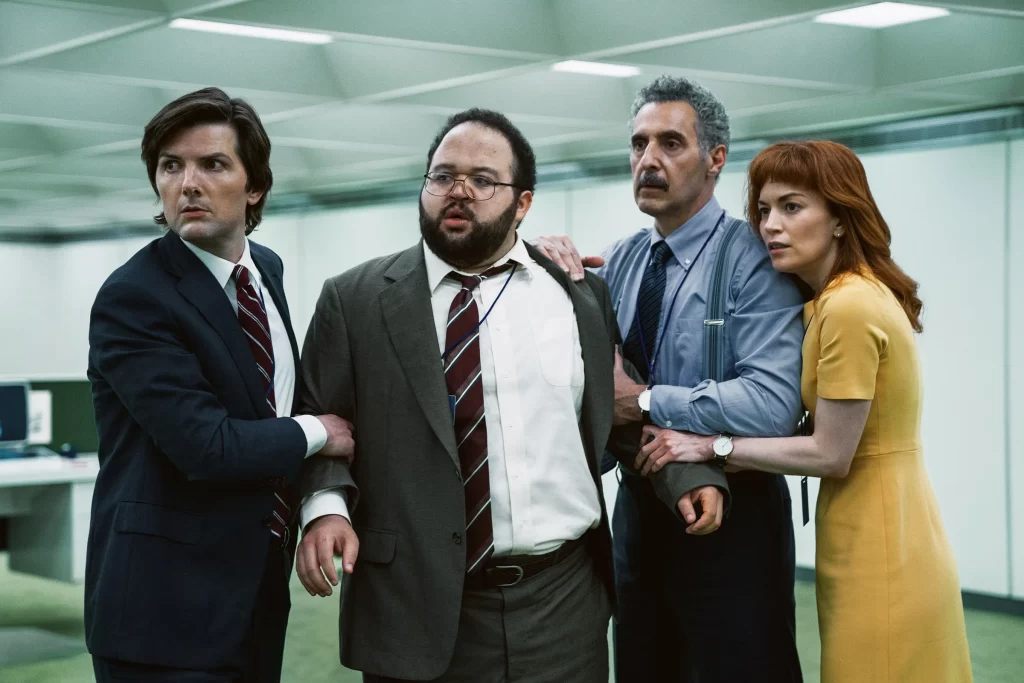Apple TV’s Severance is, in my opinion, one of the most meticulously crafted TV shows in recent history and the best TV show I’ve ever watched. It’s a psychological thriller bordering on workplace satire that is able to thrive thanks to its insane precision and purposeful writing. Every element, from the cinematography and production design to its dialogue and pacing, has meaning that only reinforces the show’s central themes of corporate control, identity, morality, and the oppression of free will.
Created by Dan Erickson and directed by Ben Stiller and Aoife McArdle, Severance shows the viewer a dystopian workplace setting where employees of the company Lumonundergo a surgical procedure called severance that splits their consciousness into two separate personas: the “innie” (work self) and the “outie” (outside-of-work-self). The show follows four central characters through their time at Lumon working in the Macrodata Refinement division. The idea of severance and its implications is explored through a deliberately constructed world that leaves no detail without purpose.
From the very first episode, Severance establishes its commitment to visual storytelling, using a cold, minimalistic aesthetic to evoke a feeling of both sterility and uneasiness. The office is set up like a labyrinth, it has an almost claustrophobic layout to mirror the employees disoriented state of being. The use of long tracking shots emphasize the eerie feeling of the workplace, while star lighting creates an unsettling contrast between the sterile, white walls of Lumon, and the real world. The cinematography does more than just at the mood, it reinforces the theme of total control. Characters are frequently framed and wide shots that make them seem small inside the corporate environment, further emphasizing their powerlessness. Meanwhile, close-ups, capture, micro expressions of doubt and fear, making every feeling Seem monumental. The consistent symmetry of the office space also seems to suggest there is an underlying force controlling every detail.
The shows narrative structure is also extremely intentional, and it moves, adding methodical and slow pace to mirror the frustration of the employees that are trapped within Lumons severed The shows narrative structure is also extremely intentional, and it moves, adding methodical and slow pace to mirror the frustration of the employees that are trapped within Lemons severed floor. Every choice, from the odd work Every choice, from the odd work that Macrodata Refinement does to the unnerving “wellness sessions”, serves the purpose of furthering the mystery of what Lumon is and does.
Each character’s story arc is also crafted to show different sides of the severance experiment. Mark Scout or Mark S., the show’s main character, is not only grieving the death of his wife, but I believe his choice to become severed is a metaphor for his emotional avoidance. Helly R. has a similar role to the audience, as the viewer is walked through the severance process along with her and learning as she goes. Even the heartwarming connection that Irving and Burt share is a way to show that human connection will persist regardless of the circumstances.
Every element, even when it seems trivial, is meticulously placed to move the story forward and provide easter eggs throughout the timeline. The childish treatment of the employees, the eerie tone of the higher-ups, and the odd prizes awarded for productivity all highlight how corporations have the power to manipulate their workers through enough psychological conditioning. Even the company’s cult-like obsession with the founder Kier Eagenis another hint at the forced loyalty and idolization that can come from these types of corporations.
In my opinion, the largest factor that sets Severance apart from any other TV show I’ve seen is the fact that it doesn’t rely on constant action and twists to keep the viewer enthralled in the story. Severance challenges the intelligence of its audience and urges them to have patience while paying attention to every detail. From something as small as the placement of an object in the office, to an offhand comment, the show’s creators have proved to the audience time and time again that if you invest yourself in trying to solve the mystery, you will find many hints and foreshadowing along the way. This dedication to intricacy only makes the show that much more satisfying and rewarding to watch.
Like I said in the beginning, Severance is the best TV show I’ve ever watched for reasons far beyond the few I was able to point out. It’s not just another mystery, but instead a masterclass in deliberate storytelling where every choice; narrative, visual, etc, serves to reinforce the themes of control, human identity, and morality in the workplace. The show’s ability to use a slow-burn approach to build suspense coupled with its unique precision and purpose completely immerses the audience in a new world that leaves the viewer wanting more after every episode.


